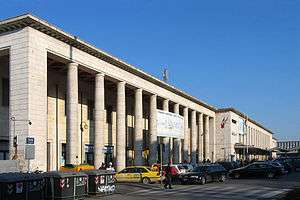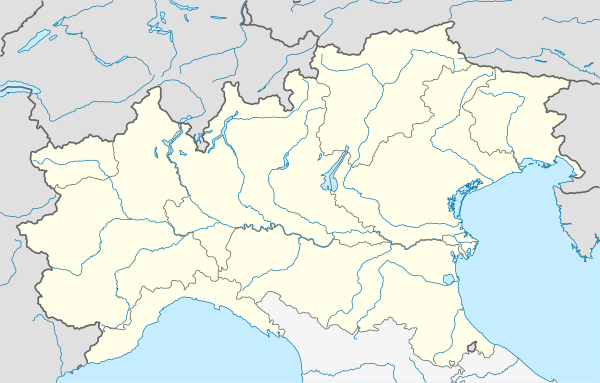Padova railway station
Padova | |
|---|---|
 The passenger building. | |
| Location |
Piazzale Stazione 1 35131 Padova Padua, Padua, Veneto Italy |
| Coordinates | 45°25′03″N 11°52′49″E / 45.41750°N 11.88028°ECoordinates: 45°25′03″N 11°52′49″E / 45.41750°N 11.88028°E |
| Owned by | Rete Ferroviaria Italiana |
| Operated by | Centostazioni |
| Line(s) |
Milan–Venice Padova–Bologna Bassano del Grappa–Padova Calalzo–Padua Padova–Padova Interporto |
| Train operators |
Trenitalia Thello Nuovo Trasporto Viaggiatori |
| Connections |
|
| History | |
| Opened | 3 December 1842 |
| Location | |
 Padova Location within Northern Italy | |
Padova railway station, or Padua railway station (Italian: Stazione di Padova), sometimes referred to as Padova Centrale, is the main station serving the city and comune of Padua, in the Veneto region, northeastern Italy.
Opened in 1842, the station forms part of the Milan–Venice railway, and is a junction for direct branch lines to Bologna, Bassano del Grappa and Camposampiero (junction for the line to Calalzo). Padova railway station is also the terminus of a short goods line to Padova Interporto.
The station is currently managed by Rete Ferroviaria Italiana (RFI). However, the commercial area of the passenger building is managed by Centostazioni. Each of these companies is a subsidiary of Ferrovie dello Stato (FS), Italy's state-owned rail company. Train services to and from the station are operated by Trenitalia, NTV and Thello.
Location
Padova railway station is situated in Piazzale Stazione, north of the city centre.
Features
Passenger building
The passenger building has both passenger facilities and commercial activities. These include a ticket office, a customer support office, the Club Eurostar, many automated ticket machines, a luggage deposit (also used as the sale of train tickets and SITA, FTV and CTM bus tickets), an office of the railway police, two newsagents, two bars, a supermarket, two travel agencies, a bank, a post office, three car rental offices, as well as numerous businesses and travel agencies.
Station yard
Currently the station yard is composed of:
- Passenger yard with eleven loops, of which nine (tracks 1–3, and 5–10) are equipped with platforms and the remaining two (4 and 11) are used for manoeuvres, as well as stabling of trains;
- Secondary yard (ex Yard A, ex Padova Scalo), located south of the line to Venice; used only for stabling of trains that originate or terminate at this station;
- Locomotive depot, wedged between the lines to Milan and Bologna;
- Wash stalls, located north of the line to Milan; also used for stabling of trains.
Operating under this system are the Gruppo Scambi Altichiero (ex Bivio Altichiero) and the Gruppo Scambi Montà (ex Bivio Montà). Each of these yards connects with a corresponding namesake line from Padova Campo Marte railway station, and allows freight trains coming from Bologna to continue towards Camposampiero and Milan, respectively, without having to reverse direction.
Train services
The station is one of the main railway nodes of the Italian system, with approximately 18.5 million passenger movements per year.
Around 450 passenger trains call at the station each day. They include trains of categories AV, ES *, ES *, CIS, EC, EN, Eurostar, IC, ICN, and R. The main domestic destinations served directly from Padua (all exclusively with Trenitalia trains) are Venice, Genoa, Turin, Como, Milan, Lecco, Bolzano/Bozen, Trento, Bassano del Grappa, Belluno, Calalzo di Cadore, Udine, Trieste, Mantua, Bologna, Florence, Pescara, Bari, Lecce, Rome, Naples, Messina, Palermo, Syracuse.
Some of the services to and from Bassano and Trento are operated by Trentino Trasporti using Minuetto trains, but always on behalf of Trenitalia.
The main international destinations are Nice, Paris, Geneva, Lausanne, Bern, Basel, Zürich, Schaffhausen, Innsbruck, Munich and Vienna. International trains are made up of either Trenitalia or foreign railways' rolling stock, i.e. CityNightLine (CNL, DB group) and Österreichische Bundesbahnen (ÖBB).
In addition to passenger trains, the station is affected by a number of transit freight trains operated by both Trenitalia and other companies (Ferrovie Emilia Romagna, FFS Cargo, Linea, NordCargo, Sistemi Territoriali). These trains do not stop at the station for loading and unloading, as it has had no freight facilities since the 1990s; the freight facilities are now all concentrated at the Padova Interporto railway station.
The following services call at the station:
- High speed services (Frecciargento) Naples - Rome - Florence - Bologna - Padua - Venice
- High speed services (Frecciabianca) Turin - Milan - Verona - Padua - Venice - Trieste
- High speed services (Frecciabianca) Milan - Verona - Padua - Venice - Treviso - Udine
- High speed services (Frecciabianca) Lecce - Bari - Ancona - Rimini - Padua - Venice
- High speed services (Italo) Salerno - Naples - Rome - Florence - Bologna - Padua - Venice
- Intercity services (EuroCity) Munich - Innsbruck - Verona - Padua - Venice
- Intercity services (EuroCity) Geneva - Lausanne - Brig - Milan - Verona - Padua - Venice
- Intercity services (Intercity) Rome - Florence - Bologna - Padua - Venice - Trieste
- Night train (Thello) Paris - Milan - Verona - Padua - Venice
- Night train (Intercity Notte) Rome - Bologna - Padua - Venice - Trieste
- Express services (Regionale Veloce) Bologna - Ferrara - Rovigo - Padua - Venice
- Express services (Regionale Veloce) Verona - Vicenza - Padua - Venice
- Regional services (Treno regionale) Verona - Vicenza - Padua - Venice
- Regional services (Treno regionale) Bologna - Ferrara - Rovigo - Monselice - Padua
- Regional services (Treno regionale) Bassano del Grappa - Citadella - Padua
- Regional services (Treno regionale) Padua - Castelfranco Veneto - Treviso
- Regional services (Treno regionale) Padua - Castelfranco Veneto - Montebelluna
- Regional services (Treno regionale) (Vicenza -) Padua - Castelfranco Veneto - Montebelluna - Belluno (- Ponte nelle Alpi - Calalzo-Pieve di Cadore)
Interchange
In the square in front of the passenger building are the termini of most of Padua's urban bus lines and the Translohr line (referred to simply as "tram"), all managed by APS. In addition, many provincial bus lines operated by APS, SITA, CTM, FTV, plus some national bus companies, include a stop at the station.
In June 2010, an intermodal centre was opened near the Chiesa della Pace, close to the railway station. It includes a 14 lane bus station, which serves as the terminus of several suburban lines, operated by a variety of transportation companies: APS, SITA, CTM, FTV, ACTV.[1]
See also
- History of rail transport in Italy
- List of railway stations in Veneto
- Rail transport in Italy
- Railway stations in Italy
References
Notes
- ↑ "Padova, al via l'intermodalità cittadina" [Padua, the city of road intermodality]. Ferrovie.it (in Italian). Ferrovie.it. 15 June 2010. Retrieved 21 November 2012. External link in
|work=(help)
Further reading
- Cornolò, Giovanni (2005). La Società Veneta Ferrovie (in Italian). Ponte San Nicolò (PD): Duegi Editrice. ISBN 88-900979-6-5.
- Santinello, Mario (1979). La Ferrovia Padova - Piazzola - Carmignano (in Italian). Cortona (AR): Calosci.
External links
![]() Media related to Padova railway station at Wikimedia Commons
Media related to Padova railway station at Wikimedia Commons
This article is presently being translated from the Italian language version. Further paragraphs will be published soon.